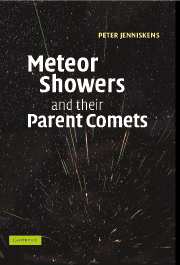Book contents
- Frontmatter
- Dedication
- Contents
- Preface
- Acknowledgements
- Part I Introduction
- Part II Parent bodies
- Part III Young streams from water vapor drag
- Part IV Young streams from comet fragmentation
- Part V Old streams and sporadic meteoroids
- 26 Annual showers
- 27 Dispersion from gradually evolving parent body orbits
- 28 The ecliptic streams
- 29 Toroidal streams
- 30 Meteor showers from asteroids
- 31 Sporadic meteors and the zodiacal cloud
- Part VI Impact and relevance of meteor showers
- Appendix
- Tables
- Index
- Units and constants
29 - Toroidal streams
from Part V - Old streams and sporadic meteoroids
Published online by Cambridge University Press: 05 July 2015
- Frontmatter
- Dedication
- Contents
- Preface
- Acknowledgements
- Part I Introduction
- Part II Parent bodies
- Part III Young streams from water vapor drag
- Part IV Young streams from comet fragmentation
- Part V Old streams and sporadic meteoroids
- 26 Annual showers
- 27 Dispersion from gradually evolving parent body orbits
- 28 The ecliptic streams
- 29 Toroidal streams
- 30 Meteor showers from asteroids
- 31 Sporadic meteors and the zodiacal cloud
- Part VI Impact and relevance of meteor showers
- Appendix
- Tables
- Index
- Units and constants
Summary
In the early nineties, satellite impact hazard models erroneously assumed that geocentric meteor radiants were spread evenly over the sky relative to the moving Earth. Jim Jones and Peter Brown in Canada and Andrew Taylor at Adelaide took stock of our knowledge of the overall radiant distribution from radar data by tackling the observing bias. They identified six principal source areas on the sky. Next to the North and South Apex source from Halley-type and long-period comet showers (15–28% of meteoroids), and the Helion and Antihelion sources of the ecliptic Jupiter-family comet streams (30–40% each), they also confirmed earlier reported North and South “Toroidal” sources at high ∼67° latitude (Fig. 28.4). These meteoroids moved in nearly circular orbits at steep angles to the ecliptic plane. They had a very small semimajor axis a ∼ 1.0 AU, not so elongated e ∼ 0.3, and a prograde high inclination (i ∼ 60°). The Toroidal meteoroids surround Earth in a volume that has the shape of a car tire, with Earth on the open inside of the torus.
Toroidal meteoroid orbits dominate the radar orbit database and are a separate source from ecliptic meteoroids only because of the competing factors of increased likelihood of detection by radar and of decreasing numbers with increasing latitude of the radiant and entry speed of the meteors. After correcting for bias, the Toroidal source all but disappeared, with only 3–6% of all meteors coming from this region. Jim Jones has since taken the view that the Toroidal meteoroids are merely the high-inclination tail of a continuous distribution of dust from the Helion and Antihelion sources.
Some 100 out of 275 streams extracted from the Harvard Radio Meteor Project radar data by Zdenek Sekanina are Toroidal streams, most in the fall and the winter. In Table 7, I mainly list streams that were confirmed by other techniques, and that includes most of Sekanina's Antihelion, Helion, and Apex streams, but very few of his Toroidal streams.
- Type
- Chapter
- Information
- Meteor Showers and their Parent Comets , pp. 515 - 519Publisher: Cambridge University PressPrint publication year: 2006



